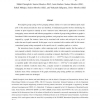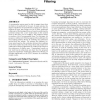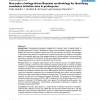393 search results - page 4 / 79 » Identifying Most Predictive Items |
BMCBI
2005
13 years 7 months ago
2005
Background: In the clinical context, samples assayed by microarray are often classified by cell line or tumour type and it is of interest to discover a set of genes that can be us...
GCB
1998
Springer
13 years 11 months ago
1998
Springer
The leucine zipper is a dimerization domain occurring mostly in regulatory and thus in many oncogenic proteins. The leucine repeat in the sequence has been traditionally used for ...
CORR
2010
Springer
13 years 7 months ago
2010
Springer
Non-adaptive group testing involves grouping arbitrary subsets of n items into different pools. Each pool is then tested and defective items are identified. A fundamental question...
SIGIR
2008
ACM
13 years 7 months ago
2008
ACM
A recommender system must be able to suggest items that are likely to be preferred by the user. In most systems, the degree of preference is represented by a rating score. Given a...
BMCBI
2007
13 years 7 months ago
2007
Background: Computational prediction methods are currently used to identify genes in prokaryote genomes. However, identification of the correct translation initiation sites remain...



